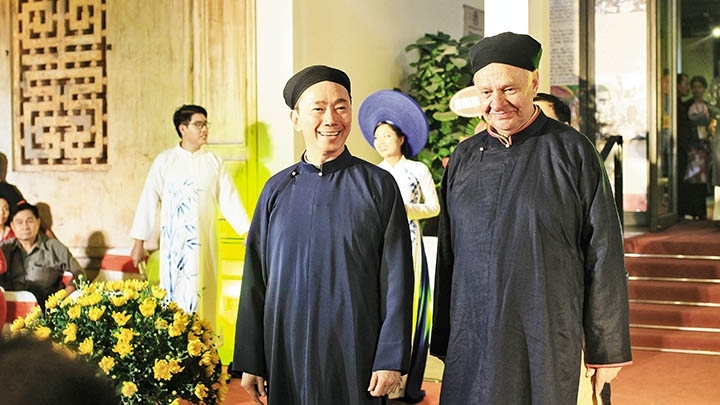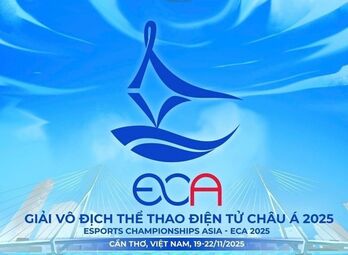
Vietnamese diplomat Phạm Sanh Châu (L) and Russian Ambassador to Vietnam, Konstatin Vnukov dressed in Vietnamese Ao Dai and turban at an event honouring the Vietnamese traditional Ao Dai for men in Hanoi in November, 2017
An event honouring the Vietnamese traditional Ao Dai for men was held in November, 2017 at the Old Quarter Culture Exchange Centre in Hanoi as part of the celebration for Vietnamese Heritage Day (November 23).
All attention on the opening day was focused on a special guest: the Russian Ambassador to Vietnam, Konstatin Vnukov. The Ambassador appeared on the stage in Vietnamese Ao Dai and turban, which were tailored by artisans from acclaimed Trach Xa Tailoring Village in Ung Hoa district, Hanoi under the consult of Dinh Lang Viet (Vietnamese Communal House) group.
However, there are not many cultural events in which Vietnamese Ao Dai for men have an opportunity to shine.
Looking back to the past, according to historical documents, including ‘Phu Bien Tap Luc’ (Miscellaneous Records on the Pacification of the Frontier) the by historian Le Quy Don, Vietnamese Ao Dat dated to the 18th century. Nguyen Phuc Khoat, one of Nguyen Lords, was the one who created the design of this clothing in order to distinguish with Han-Chinese clothing.
To keep Vietnamese's culture, he ordered a document describing the design of Vietnamese's clothes which was similar to Ao Dai nowadays. Ao Dai was required to be worn by the southern courtiers under his reign, and it was also popular among intellectuals and elites in the society until the first half of the 19th century.
As it used to be worn by the elites, researchers have shown that details in Vietnamese Ao Dai for men have specific implications of philosophy. For example, the ‘ngu than’ tunic in the 19th century had five flaps implying oneself in the connection with four others including his parents and parents of his spouse.
The traditional Vietnamese Ao Dai for men has five buttons, presenting the five cardinal virtues (humaneness, righteousness, proper rite, knowledge, and integrity). It was in light and elegant colours without embroidery decorations, allowing it to be well suited with different types of shoes and pants.
The turning point in the history of Vietnamese Ao Dai for men was marked by the presence of the French and Western wear in the country at the end of the 19th century. Western wear was popularized and won much favour with the Western-educated people in Vietnam at that time, while Ao Dai was modified to provide for comfort status and satisfaction of the wearer: the loose sleeves were tighten and the turban for men became ready-to-wear rather than being tied manually. Notably, in the northern region, and flap in male Ao Dai was shortened and was placed above the wearer’s ankle.
In the 1930s when the Western culture had extended influence on Vietnam, Ao Dai for male fell into disfavour and was gradually replaced by Western clothes. According to Hanoi-based photographer Nguyen Huu Bao, typical clothes wore by members of elite families were described as follow: “the father in Ao Dai and turban, the mother in four-flap dress, the son in suit and felt hat, and the daughter-in-law in dress.
However, Ao Dai for males have still remained its enduring vitality. According to historian Duong Trung Quoc, during the period after August Revolution 1945, Ao Dai and turban were still chosen by Government Ministers such as Huynh Thuc Khang and Nguyen Van To at solemn events. President Ho Chi Minh also wore the outfit when he joined a celebration for lunar New Year’s Eve in Hanoi on 1946.
After 1954 and during wartime, Ao Dai for male was gradually absent from people’s daily life as people demanded simplicity and convenience. The major obstacle for men to wear the costume is people’s awareness. Many people think that if modern men wear such costume, it symbolises a return to backward feudalism.
However, at the same starting point with Ao Dai for male, Ao Dai for women is luckily enough treated in a completely different way. During 1930s, thanks to creativity of painters Le Pho and Cat Tuong, the outfit became more fashionable and elegant. It has been continuously developed and popularised in the daily life, and is now considered as an iconic traditional costume for women.
In 2013, a survey on Vietnamese national outfit for men and women, conducted by the Department of Fine Arts, Photography and Exhibition, showed that 100% respondents agreed to pick Ao Dai as a national outfit for women, but Ao Dai for males only gardners 3% approval. 12% of participants suggested that the suit as a national costume for men, and typical patterns of Vietnamese culture could be blended in the suit in order to bring a traditional appearance for it.
According to painter Nguyen Manh Duc, the prolonged interruption in the history of Ao Dai for male makes it become some how old-fashioned and not suitable in people’s awareness in modern life. Efforts have been to retouch and modify the traditional costumes to make it more popular among the community, but they have not seen much success, he said.
He pointed out that some designers have fallen into adding complicated and miscellaneous patterns into the outfit attempting to mix the robe with a shirt or jacket rather than honouring and promoting simplicity and decentness of the original version.
For both men and women, Ao Dai is not a costume, but a cultural heritage of the nation which has been preserved for centuries. While Ao Dai for women has received considerable attention and favour, greater efforts are needed to help Ao Dai for males in order to make a comeback and further promote itself in the modern life./.
NDO
 Vietnam to host Asian Esports Championships for the first time
Vietnam to host Asian Esports Championships for the first time



